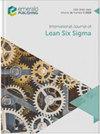实施和维持精益、买方-供应商角色和新冠肺炎大流行:来自孟加拉国服装行业的见解
IF 3.7
2区 工程技术
Q2 ENGINEERING, INDUSTRIAL
引用次数: 2
摘要
本研究旨在探讨服装供应商工厂实施和维持精益所面临的挑战,以及在典型情况和大流行情况下,买方-供应商在减轻精益障碍中的作用。设计/方法/方法采用定性研究方法和多重嵌入式案例研究方法,通过对孟加拉国一家主要买家及其四家主要服装供应商工厂的高级管理人员进行深入访谈,收集数据。在案例分析和跨案例分析中,应用了技术来理解面向环境的精益挑战和买方-供应商在减轻挑战中的作用。研究结果表明,服装供应商在精益实施方面准备不足,缺乏系统性,能力有限,准备不足。此外,他们得到的买家支持有限,高层管理人员的承诺较少,员工对实施精益的抵制也较少。由于COVID-19大流行,精益挑战变得更加严峻。然而,买方-供应商负责任、合作和协作行为可以减轻精益挑战。虽然许多利益相关者可能对精益挑战负责,但本研究仅基于单个主要买家和他们的四个供应商,探讨了买方和供应商之间的二元角色。因此,未来的研究可以考虑更多的买家和供应商,以全面了解。实际意义本研究可以帮助买方和供应商了解服装供应商工厂精益实施挑战的潜在原因,以及他们在维持精益减少挑战方面的作用,特别是在流行病中。原创性/价值据作者所知,本研究首次描述了在大流行的情况下,买方和供应商如何发挥其应有的作用,以减轻服装供应商工厂的精益挑战。本文章由计算机程序翻译,如有差异,请以英文原文为准。
Implementing and sustaining lean, buyer-supplier role, and COVID-19 pandemic: insights from the garment industry of Bangladesh
Purpose This study aims to explore the challenges in implementing and sustaining lean in garment supplier factories and the buyer–supplier role in mitigating lean barriers in a typical situation and pandemic. Design/methodology/approach Following a qualitative research approach and multiple embedded case study method, data were collected through in-depth interviews with senior managers of one lead buyer and their four key garment supplier factories in Bangladesh. Within and cross-case analysis, techniques were applied to understand the context-oriented lean challenges and buyer–supplier role in mitigating the challenges. Findings The study findings demonstrate that garment suppliers are less prepared and unsystematic in lean implementation having limited capabilities and less preparation. Moreover, they have limited support from buyers, less commitment from top management and employee resistance to implementing lean. Lean challenges become more intense because of the COVID-19 pandemic. However, buyer–supplier responsible, cooperative and collaborative behaviour can mitigate lean challenges. Research limitations/implications Whereas many stakeholders may be responsible for lean challenges, this study explores dyadic role between buyer and supplier only based on a single lead buyer and their four suppliers. Hence future studies could consider more buyers and suppliers for a holistic understanding. Practical implications This study could help buyers and suppliers understand the underlying causes of lean implementation challenges in garment supplier factories and their role in sustaining lean reducing the challenges, particularly in a pandemic. Originality/value To the best of the authors’ knowledge, for the first time, this study depicts how buyer and supplier can play their due roles to mitigate lean challenges in garment supplier factories in a pandemic situation.
求助全文
通过发布文献求助,成功后即可免费获取论文全文。
去求助
来源期刊

International Journal of Lean Six Sigma
Engineering-Industrial and Manufacturing Engineering
CiteScore
8.90
自引率
15.00%
发文量
46
期刊介绍:
Launched in 2010, International Journal of Lean Six Sigma publishes original, empirical and review papers, case studies and theoretical frameworks or models related to Lean and Six Sigma methodologies. High quality submissions are sought from academics, researchers, practitioners and leading management consultants from around the world. Research, case studies and examples can be cited from manufacturing, service and public sectors. This includes manufacturing, health, financial services, local government, education, professional services, IT Services, transport, etc.
 求助内容:
求助内容: 应助结果提醒方式:
应助结果提醒方式:


